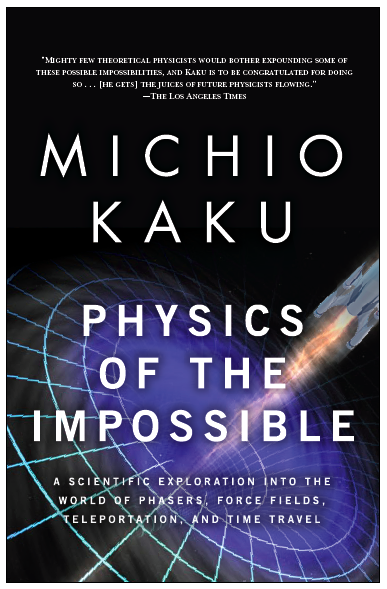Physics of the Impossible - Michio Kaku

Rating 10/10
My Summary:
Kaku looks at all of our favorite sci-fi concepts and discusses their feasibility based on our current conception of physics. He classifies concepts into three categories; impossible today but will be possible in the future, may or may not be possible in the future, and definitely never possible. A fantastic focus on concepts such as teleportation, time travel, interstellar travel and more. The day after I read the chapter on teleportation (involving super cooling boron atoms so that information could be stored in their now static orientation), I had a great, fully nude chat with an eastern european PHD student in the MIT sauna who studied the topic. So, clearly a book worth reading.
Quotes
So it is possible to create a high-energy device that resembles a light saber. But as with ray guns, you would have to create a high-energy portable power pack. Either you would need long cables connecting the light saber to a power supply, or you would have to create, via nanotechnology, a tiny power supply that could deliver huge amounts of power.
The ITER in Cadarache, in southern France, is designed to heat hydrogen gas to 100 million degrees centigrade. It could become the first fusion reactor in history to generate more energy than it consumes. It is designed to generate 500 megawatts of power for 500 seconds (the current record is 16 megawatts of power for 1 second). The ITER should generate its first plasma by 2016 and be fully operational in 2022. At a cost of $12 billion, it is the third most expensive scientific project in history (after the Manhattan Project and the International Space Station).
[Einstein on randomness in the quantum model} “Quantum mechanics calls for a great deal of respect. But some inner voice tells me that this is not the true Jacob. The theory offers a lot, but it hardly brings us any closer to the Old Man’s secret. For my part, at least, I am convinced that He doesn’t throw dice.”
Gamblers also are able to read people’s minds in a limited sense. When a person sees something pleasurable, the pupils of his eyes usually dilate. When he sees something undesirable (or performs a mathematical calculation), his pupils contract. Gamblers can read the emotions of their poker-faced opponents by looking for their eyes to dilate or contract. This is one reason that gamblers often wear colored visors over their eyes, to shield their pupils. One can also bounce a laser beam off a person’s pupil and analyze where it is reflected, and thereby determine precisely where a person is looking. By analyzing the motion of the reflected dot of laser light, one can determine how a person scans a picture. By combining these two technologies, one can then determine a person’s emotional reaction as he scans a picture, all without his permission.
Our brain, however, is not a digital computer. Our brain has no Pentium chip, no CPU, no Windows operating system, and no subroutines. If you remove a single transistor in the CPU of a computer, you are likely to cripple it. But there are recorded cases in which half the human brain can be missing, yet the remaining half of the brain takes over.
A new scientific truth does not triumph by convincing its opponents and making them see the light, but rather because its opponents eventually die, and a new generation grows up that is familiar with it. —MAX PLANCK
As Russian novelist Fyodor Dostoevsky wrote, “If everything on Earth were rational, nothing would happen.”
Commenting on the lack of emotions in robots, Dr. Rosalind Picard of the MIT Media Lab says, “They can’t feel what’s most important. That’s one of their biggest failings. Computers just don’t get it.”
Certain things, he reasoned, are easy to communicate, such as the shape of our bodies and the number of our fingers, arms, and legs. We can even explain to the aliens the laws of chemistry and biology. But if we try to explain to them the concept of “left” and “right” (or “clockwise” and “counterclockwise”), we would fail each time. We would never be able to explain to them that our heart is on the left side of our body, in which direction the Earth rotates, or the way a DNA molecule spirals.
In the quantum theory things are more complicated. T [time] -reversal by itself violates the laws of quantum mechanics, but the full CPT-reversed universe is allowed. This means that a universe in which left and right are reversed, matter turns into antimatter, and time runs backward is a fully acceptable universe obeying the laws of physics!
At a minimum, I realized, Noether’s theorem means that the conservation of energy will probably last for billions of years, if not forever. As far as we know, none of the fundamental laws of physics have changed with time, and this is the reason that energy is conserved.
Header photo © inspirefirst.com
Body photo © skagency.com